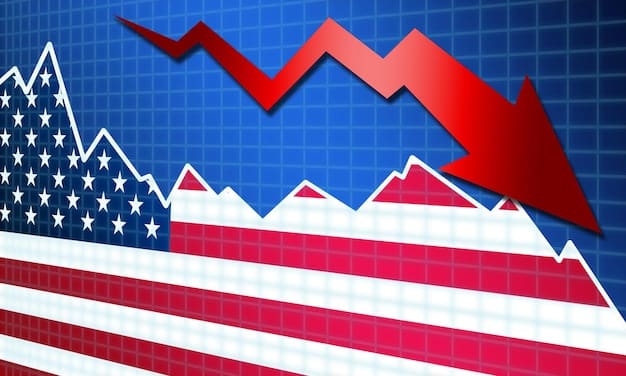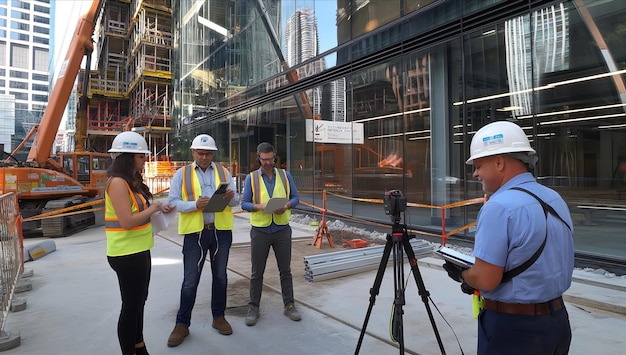Jobless Claims Hit 6-Month Low: Economic Signals & US Impact

Jobless claims in the US have fallen to their lowest level in six months, signaling potential strength in the labor market, but also raising questions about the Federal Reserve’s monetary policy and the overall economic outlook.
The recent drop in jobless claims fall to lowest level in 6 months: what does this signal for the us economy? This dip has sparked optimism and speculation about the true state of the US economy. Are we witnessing a genuine recovery, or is this a temporary blip?
Understanding the Significance of Jobless Claims
Jobless claims, also known as initial unemployment claims, represent the number of individuals who have filed for unemployment benefits for the first time. These claims are a key indicator of the health of the labor market. A decreasing number of claims often suggests that fewer people are losing their jobs, and the labor market is strengthening.
Conversely, an increasing number of claims could signal layoffs, economic slowdown, or recession. Therefore, monitoring these claims is crucial for understanding broader economic trends.
How Jobless Claims Are Calculated
The U.S. Department of Labor releases jobless claims data weekly. This data reflects the number of new claims filed during the previous week. The calculation involves summing up all the new applications for unemployment benefits across all states and territories.
- Initial Claims: Represent the number of people filing for unemployment for the first time.
- Continuing Claims: Reflect the number of people who continue to receive unemployment benefits after their initial claim.
- Insured Unemployment Rate: Measures the percentage of the labor force receiving unemployment benefits.
Analyzing these figures helps economists and policymakers gauge the current state of employment and predict future economic conditions.

In conclusion, jobless claims are a vital economic indicator that provides insights into the labor market’s health. Monitoring these claims can help anticipate economic shifts and inform policy decisions.
Analyzing the Recent Drop in Jobless Claims
The recent drop in jobless claims to a six-month low is a noteworthy development that warrants careful analysis. While it may indicate a strengthening labor market, several factors could be contributing to this decline. Understanding these factors is essential for assessing the true implications of this trend.
It’s important to consider whether this decline is a sustainable trend or a short-term fluctuation. Seasonality, changes in industry, government policies, and the overall economic climate can influence jobless claims.
Potential Reasons Behind the Decline
Several factors might explain the recent decrease in jobless claims. These include, but are not limited to, increased hiring by companies, fewer layoffs, and a more resilient economy than initially anticipated.
For instance, certain sectors could be experiencing growth, leading to more job opportunities and fewer unemployment filings. Additionally, companies may be holding onto their employees due to labor shortages.
- Stronger Economic Growth: Increased economic activity generally leads to more hiring and fewer layoffs.
- Labor Shortages: The scarcity of available workers can prompt employers to retain existing staff.
- Seasonal Adjustments: Government adjustments to account for seasonal hiring patterns.
By examining these elements, a clearer picture of the labor market can emerge, providing a more accurate assessment of the decline in jobless claims.

In summary, the decline in jobless claims is a significant economic event. Understanding the underlying causes requires a detailed examination of various economic forces and labor market dynamics.
The Impact on the Federal Reserve’s Monetary Policy
The Federal Reserve (the Fed) closely monitors economic indicators like jobless claims to make informed decisions about monetary policy. A significant drop in jobless claims can influence the Fed’s approach to interest rates, inflation control, and overall economic stability.
Based on this data, the Fed might adjust its strategies to align with the current economic conditions and maintain a balance between employment and inflation. Understanding the Fed’s perspective is vital for assessing the broader financial implications.
How the Fed Reacts to Declining Jobless Claims
Declining jobless claims can lead the Federal Reserve to consider tightening monetary policy. This might involve raising interest rates to prevent the economy from overheating and to keep inflation in check.
However, the Fed must also weigh other economic factors to ensure that policy adjustments do not unduly stifle economic growth.
- Interest Rate Adjustments: Raising rates can curb inflation but may also slow economic growth.
- Inflation Targets: The Fed aims to maintain a stable inflation rate, typically around 2%.
- Balance Sheet Management: Adjusting the Fed’s holdings of government bonds and other assets to influence financial conditions.
Considering these factors, the Fed’s response to decreasing jobless claims is multifaceted and carefully calibrated to achieve its broader economic goals.
In conclusion, the Federal Reserve’s decisions are highly influenced by indicators like jobless claims. Its monetary policy adjustments play a crucial role in shaping the economic landscape and managing financial stability.
Sector-Specific Insights and Trends
Analyzing jobless claims data by sector can provide valuable insights into which industries are thriving or struggling. Different sectors respond uniquely to broader economic trends, and understanding these nuances is crucial for a comprehensive analysis.
Certain sectors may be experiencing growth and hiring, while others could be facing layoffs. These sector-specific trends can offer a more granular view of the labor market.
Identifying Thriving and Struggling Sectors
Some sectors, such as technology and healthcare, might be experiencing strong growth and increased hiring. Meanwhile, others like retail or hospitality could be facing challenges due to changing consumer behavior or economic pressures.
It is important to look into the particularities of specific sectors to assess their impacts on jobless claims.
- Technology Sector: Often experiences growth due to innovation and demand for digital solutions.
- Healthcare Sector: Remains stable due to consistent healthcare needs.
- Retail Sector: Can fluctuate based on consumer spending and seasonal trends.
By examining these sector-specific trends, a more nuanced understanding of the labor market dynamics can be achieved.
In summary, delving into sector-specific data reveals valuable insights into the nuanced performance of various industries, contributing to a more comprehensive understanding of the overall labor market.
The Role of Government Policies and Initiatives
Government policies and initiatives play a significant role in influencing jobless claims. Unemployment benefits, job training programs, and economic stimulus measures can all impact the number of people filing for unemployment.
These interventions can either mitigate job losses or encourage workforce participation. Understanding these policy dynamics is essential for evaluating the true effect of jobless claims data.
How Policies Affect Jobless Claims
Government policies can either increase or decrease jobless claims. For instance, extended unemployment benefits might encourage some individuals to remain unemployed for longer, while job training programs can help people find new employment faster.
Analyzing these policies is key to understanding their overall impact.
- Unemployment Benefits: Provide a safety net for those who lose their jobs but can also prolong unemployment.
- Job Training Programs: Equip individuals with new skills, increasing their chances of finding employment.
- Economic Stimulus: Boost economic activity, leading to more job creation.
By carefully evaluating these policies, a more accurate assessment of the underlying labor market conditions can be made.
In conclusion, government policies and initiatives exert considerable influence on jobless claims, shaping labor market dynamics and influencing the overall economic landscape.
Comparing Current Trends with Historical Data
Comparing current jobless claims trends with historical data is crucial for gaining perspective and understanding the context of the current economic situation. Historical trends provide insights into how the labor market has evolved over time and how it responds to different economic cycles.
By analyzing past patterns, better predictions about future trends can be made and evaluate the severity and duration of current economic conditions.
Lessons from Past Economic Cycles
Past economic recessions and recoveries can offer valuable lessons about how jobless claims behave during different phases of the economic cycle. For example, during the 2008 financial crisis, jobless claims soared to unprecedented levels before gradually declining as the economy recovered.
Learning from these past experiences is vital to gaining a well-rounded perspective.
- Recessionary Periods: Characterized by high jobless claims and economic contraction.
- Recovery Periods: Marked by declining jobless claims and economic growth.
- Long-Term Trends: Reveal structural changes in the labor market over several decades.
By integrating historical context, a more insightful and comprehensive analysis of current jobless claims data can be produced.
| Key Point | Brief Description |
|---|---|
| 📊 Jobless Claims Drop | Claims hit a 6-month low, signaling possible labor market strength. |
| 💰 Fed’s Response | The Fed may tighten monetary policy if the trend continues. |
| 🏢 Sector Impact | Tech and healthcare are strong, while retail faces challenges. |
| policy impact | Government policies can influence jobless claims significantly. |
Frequently Asked Questions (FAQ)
▼
Jobless claims are weekly reports on the number of people applying for unemployment benefits, reflecting the labor market’s health. Lower claims suggest a stronger job market, while higher claims indicate potential weakness.
▼
The recent drop may stem from factors such as a stronger economy, fewer layoffs, or companies retaining workers due to labor shortages. Sector-specific growth in tech and healthcare also plays a role.
▼
The Federal Reserve might consider tightening monetary policy by raising interest rates to prevent inflation. They balance this with other factors to avoid stifling economic growth, aiming for stable inflation around 2%.
▼
Technology and healthcare sectors are generally seeing growth due to innovation and steady demand, contrasting with fluctuations in sectors like retail, which depend on consumer spending and seasonal patterns.
▼
Comparing current data to historical data helps contextualize the present economic condition. Lessons from past cycles show how jobless claims behave during recessions, recoveries, and long-term structural changes in the labor market.
Conclusion
In conclusion, the recent drop in jobless claims fall to lowest level in 6 months: what does this signal for the us economy? While it indicates a stronger labor market, understanding the broader economic context, sector-specific dynamics, and the Federal Reserve’s potential policy responses is crucial. Continued monitoring of these trends will provide a clearer picture of the overall economic health of the United States.





